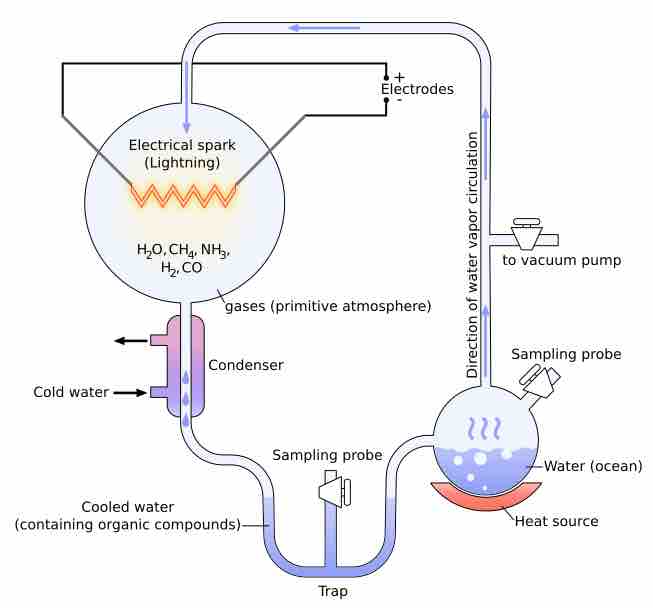There is no "standard model" of the origin of life. However, most currently accepted models draw at least some elements from the framework laid out by the Oparin-Haldane hypothesis. The Oparin-Haldane hypothesis suggests that the atmosphere of the early Earth may have been chemically reducing in nature, composed primarily of: methane (CH4), ammonia (NH3), water (H2O), hydrogen sulfide (H2S), carbon dioxide (CO2) or carbon monoxide (CO), with phosphate (PO43-), molecular oxygen (O2) and ozone (O3) either rare or absent.
In such a reducing atmosphere, electrical activity can catalyze the creation of certain basic small molecules (monomers) of life, like amino acids. This was demonstrated in the Miller–Urey experiment by Stanley L. Miller and Harold C. Urey in 1953. Phospholipids (of an appropriate length) can form lipid bilayers, a basic component of the cell membrane .

Miler-Urey Experiment
An outline of the apparatus used by Miller and Urey. Using this apparatus, and using conditions thought to approximate the conditions on pre-biotic earth, they were able to catalyze the molecules of life like amino acids.
A fundamental question is about the nature of the first self-replicating molecule. Since replication is accomplished in modern cells through the cooperative action of proteins and nucleic acids, the major schools of thought about how the process originated can be broadly classified as "proteins first" and "nucleic acids first. " The principal thrust of the "nucleic acids first" argument is as follows:
- The polymerization of nucleotides into random RNA molecules might have resulted in self-replicating ribozymes (RNA world hypothesis).
- Selection pressures for catalytic efficiency and diversity might have resulted in ribozymes which catalyse peptidyl transfer (hence formation of small proteins), since oligopeptides complex with RNA to form better catalysts. The first ribosome might have been created by this process, resulting in more prevalent protein synthesis.
- Synthesized proteins might then out-compete ribozymes in catalytic ability, therefore becoming the dominant biopolymer, relegating nucleic acids to their modern use as a carrier of genomic information.
Biologist John Desmond Bernal coined the term biopoiesis for this process,and suggested that there were a number of clearly defined "stages" that could be recognized in explaining the origin of life:
- Stage 1: The origin of biological monomers
- Stage 2: The origin of biological polymers
- Stage 3: The evolution from molecules to cell